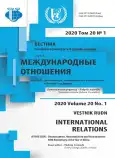Small Arms and Light Weapons (SALW) and Transnational Crime in Africa
- Авторлар: Falode A.J.1
-
Мекемелер:
- Lagos State University
- Шығарылым: Том 20, № 1 (2020): Decolonization, Neocolonialism and Recolonization: 60th Anniversary of the Year of Africa
- Беттер: 158-169
- Бөлім: PEACE AND SECURITY
- URL: https://journal-vniispk.ru/2313-0660/article/view/320199
- DOI: https://doi.org/10.22363/2313-0660-2020-20-1-158-169
- ID: 320199
Дәйексөз келтіру
Толық мәтін
Аннотация
Негізгі сөздер
Авторлар туралы
Adewunmi Falode
Lagos State University
Email: adewunmi.falode@lasu.edu.ng
PhD, Department of History and International Studies Lagos, Nigeria
Әдебиет тізімі
- Ayissi, A. & Sall, I. (2005). Combating the Proliferation of Small Arms and Light Weapons in West Africa: Handbook for the Training of Armed and Security Forces. United Nations: Programme for Coordination and Assistance for Development, United Nations Institute for Disarmament Research (UNIDIR). URL: https://unidir.org/files/publications/pdfs/combating-the-proliferation-of-small-arms-and-light-weapons-in-west-africa-handbook-for-the-training-of-armed-and-security-forces-326.pdf (accessed: 02.07.2019)
- Bourne, M. (2005). The Proliferation of Small Arms and Light Weapons. In: Krahmann, E. (Eds.). New Threats and New Actors in International Security. New York: Palgrave Macmillan. P. 155-176. DOI: 10.1057/ 9781403981660_8
- Brown, S.S. (2020). Introduction: Setting the Stage. In: Brown, S.S. & Hermann, M.G. Transnational Crime and Black Spots: Rethinking Sovereignty and Global Economy. UK: Palgrave Macmillan. P. 1-12. DOI: 10.1057/ 978-1-137-49670-6_1
- Bruinsma, G. (2015). Histories of Transnational Crime. New York: Springer-Verlag. doi: 10.1007/978-1-4939-2471-4
- Chelule, E. (2014). Proliferation of Small Arms and Light Weapons: Challenge to Peace, Development and Security in Africa. IOSR Journal of Humanities and Social Sciences (IOSR-JHSS), 19 (5), 80-87. doi: 10.9790/0837-19558087
- Ellis, S. & Shaw, M. (2015). Does Organized Crime Exist in Africa? African Affairs, 114 (457), 505-528. doi: 10.1093/afraf/adv035
- Idowu, O.I. (2019). Legal and Regulatory Challenges to Effective Implementation of the Fireams Act in Nigeria. Ede: Journal of Humanities and Social Sciences, 1 (2), 26-39.
- Jeffrey, B. & Klare, M. (1998). Small Arms and Light Weapons: Controlling the Real Instruments of War. Arms Control Today. URL: https://www.armscontrol.org/act/1998_08-09/mkas98 (accessed: 02.07.2019).
- Keili, F.L. (2008). Small Arms and Light Weapons Transfer in West Africa: A Stock-Taking. Disarmament Forum. URL: https://www.unidir.org/files/publications/pdfs/the-complex-dynamics-of-small-arms-in-west-africa-en-329.pdf (accessed: 02.07.2019).
- Krause, K. (2015). Small Arms Survey: Weapons and the World. Cambridge: Cambridge University Press.
- Kumar, S. (2008). Small Arms and Light Weapons: A Global Health to Human Security and Development. The Indian Journal of Political Science, 69 (4), 787-800.
- Lloyd, P., Simmons, B. & Stewart, B. (2012). Combating Transnational Crime: The Role of Learning and Norm Diffusion in the Current Rule of Law Wave. In: Nolkaemper, A., Zurn, M. & Peerenboom, R. (Eds.). Rule of Law Dynamics. In an Era of International and Transnational Governance. Cambridge: Cambridge University Press. P. 153-180. doi: 10.1017/CBO9781139175937.011
- Madsen, F. (2009). Transnational Organized Crime. New York: Routledge. doi: 10.4324/9780203875827
- Mystris, D. (2019). Transnational Crime in the African Union. In: Mitsilegas, V., Hufnagel, S. & Moiseienko, A. (Eds.). Research Handbook on Transnational Crime. Edward Elgar Publishing. P. 482-488. doi: 10.4337/9781784719449
- OECD. (2018). Illicit Financial Flows: The Economy of Illicit Trade in West Africa. OECD Publishing, Paris. doi: 10.1787/9789264268418-en
- Pumphrey, C. & Schwartz-Barcett, R. (2003). Armed Conflict in Africa. Scarecrow Press
- Reitano, T. (2018). Organized Crime as a Threat to Sustainable Development: Understanding the Evidence. In: Comolli, V. (Eds.). Organized Crime and Illicit Trade: How to Respond to this Strategic Challenge in Old and New Domains. New York: Palgrave Macmillan. P. 23-35. doi: 10.1007/978-3-319-72968-8_2
- Rogers, D. (2009). Postinternationalism and Small Arms Control: Theory, Politics, Security. Bodmin: Ashgate. doi: 10.4324/9781315601687
- Shaw, M. & Wannenburg, G. (2005). Organized Crime in Africa. In: Reichel, P. & Albanese, J. (Eds.). Handbook of Transnational Crime and Justice. Thousand Oaks, CA: SAGE Publications Inc. P. 367-386. doi: 10.4135/9781412976183.n18
- Shaw, M. (2014). Transnational Organized Crime in Africa. In: Albanese, J. & Reichel, P. (Eds.). Transnational Organized Crime: An Overview from Six Continents. Thousand Oaks, CA: SAGE Publications Inc. P. 93-117. doi: 10.4135/9781483349091.n6
- Sheptycki, J. & Wardack, A. (2005). Transnational and Comparative Criminology. London: Glasshouse. doi: 10.4324/9781843146049
- Siebels, D. (2020). Maritime Security in East and West Africa: A Tale of Two Regions. Switzerland: Palgrave Pivot. doi: 10.1007/978-3-030-22688-6
- Stoica, I. (2016). Transnational Organized Crime: An (Inter)national Security Perspective. Journal of Defence Resources Management, 7 (2), 14-15
- Vandome, C. & Vines, A. (2018). Tackling Illegal Wildlife Trade in Africa: Economic Incentives and Approaches. The Royal Institute of International Affairs. URL: https://www.chathamhouse.org/sites/default/files/ publications/2018-10-11-VandomeVines-Illegal-wildlife-WEB.pdf (accessed: 09.01.2020)
- Zabyelina, Y. (2009). Transnational Organized Crime in International Relations. Central European Journal of International and Security Studies, 3 (1), 11-22
Қосымша файлдар









